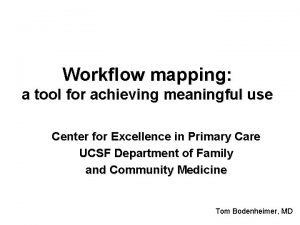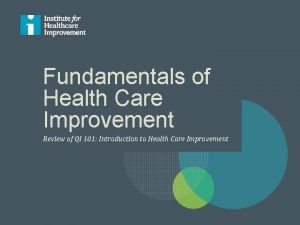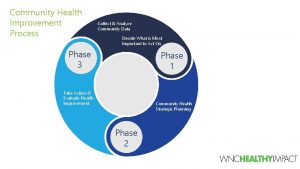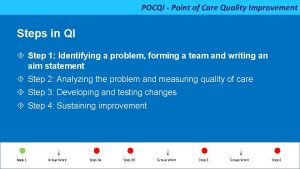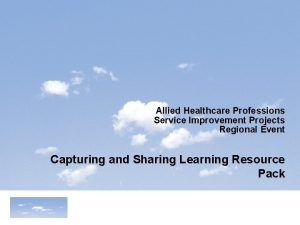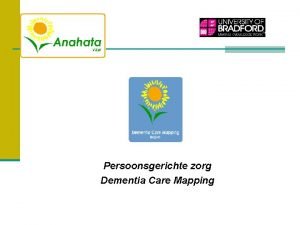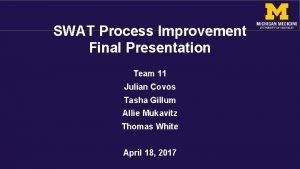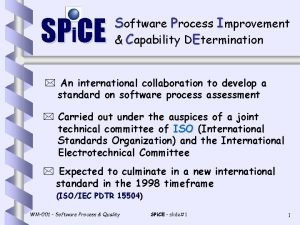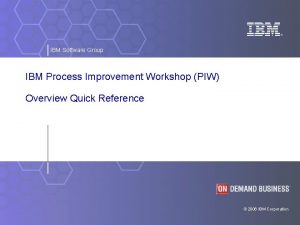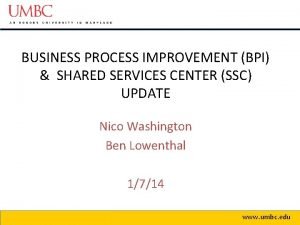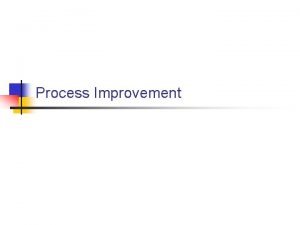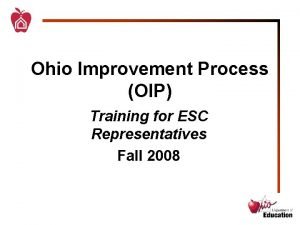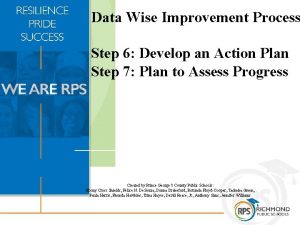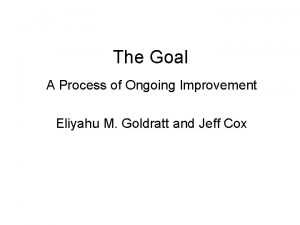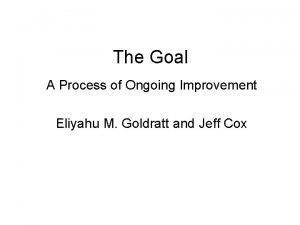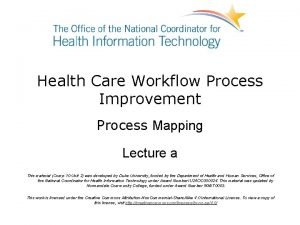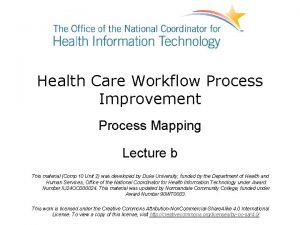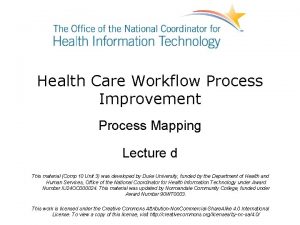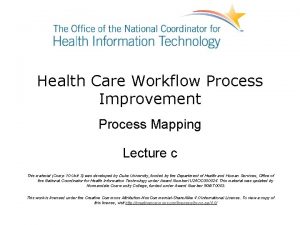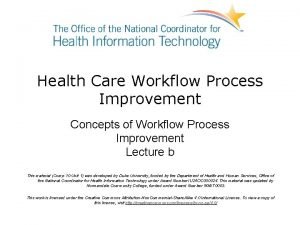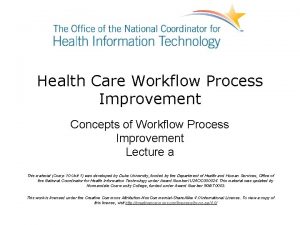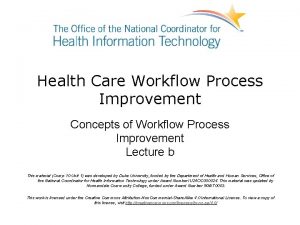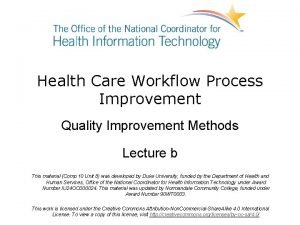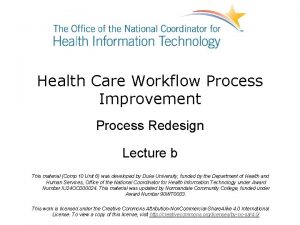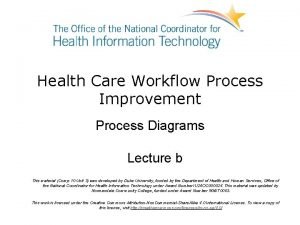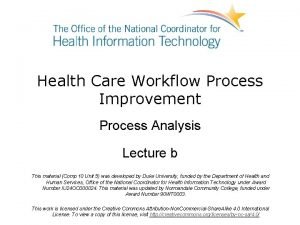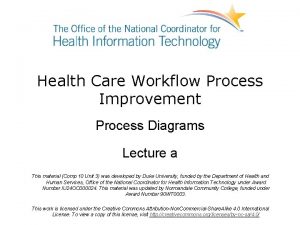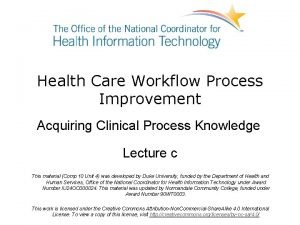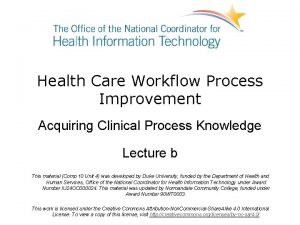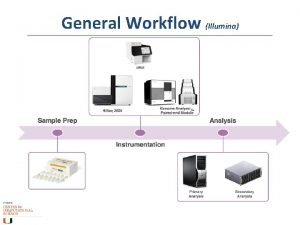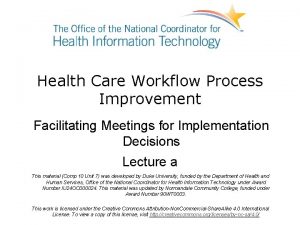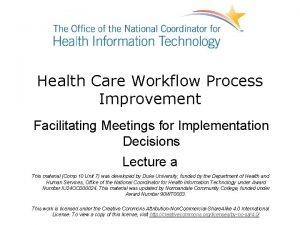Health Care Workflow Process Improvement Process Mapping Lecture































- Slides: 31

Health Care Workflow Process Improvement Process Mapping Lecture e This material (Comp 10 Unit 3) was developed by Duke University, funded by the Department of Health and Human Services, Office of the National Coordinator for Health Information Technology under Award Number IU 24 OC 000024. This material was updated by Normandale Community College, funded under Award Number 90 WT 0003. This work is licensed under the Creative Commons Attribution-Non. Commercial-Share. Alike 4. 0 International License. To view a copy of this license, visit http: //creativecommons. org/licenses/by-nc-sa/4. 0/

Process Mapping Learning Objectives • Read and interpret an entity relationship diagram in crow’s foot notation 2

Process Mapping Lecture e - Topics • Understand the background of how Entity. Relationship Diagrams (ERDs) are used and maintained, the symbol set used in producing ERDs, and process aspects covered by them • Understand the notation conventions and be able to read (not create) a simple Entity Relationship Diagram (ERD) 3

Background • Entity-Relationship Diagrams: • Are also called E-R diagrams and ERDs • Were made popular by Peter Chen in a 1976 paper and introduced by Charles Bachman in an earlier 1969 paper • Represent data and the relationships between data values • Are data models • Are used to specify or document static content, i. e. , data that are stored in a data system – NOT process steps, step sequence, or flow control 4

Your Relationship with ERDs • As a workflow analyst, you will most likely not be creating ERDs. • However, you may run into them as: – documentation provided by a prospective vendor, or – documentation that a facility has for a system • Based on the relational data model – this course does not require relational database knowledge – This course does not cover relational database topics • Therefore: • This lecture covers reading and interpreting ERDs, not how to create them. 5

ERDs and UML • ERDs and UML class diagrams basically represent the same thing: data and relationships between data values • Use different notation • Both support multiple levels of abstraction and inheritance • ERDs are often called data models • Class diagrams are referred to as information models 6

Use • ERDs are used to specify or document static content, i. e. , – Data that are or are to be stored in a data system. – Databases are built from ERDs. 7

Notation • Several notations exist for drawing ERDs, the most common is Barker, or “crow’s foot” notation. • “crow’s foot” notation is generally favored because of its readability and more efficient use of drawing space. 8

ERDs represent content: • Entities are things about which we collect and store data • Relationships describe how the data values are linked, how they fit together • Attributes are the actual pieces of data that we collect and store 9

An ERD Example Source: Adapted with permission from Bernat. 10

Entity • a person, place or thing, i. e. , noun, about which we want to collect and store data • has a name, attributes, and an identifier • the identifier uniquely identifies an instance of an entity – The attribute which acts as the identifier is marked with an asterisk 11

Relationship • a relationship between two entities is represented by a line • has a name which is a verb • also has cardinality and modality 12

Cardinality and Modality • Cardinality and Modality work together to define the relationship • Cardinality indicates the maximum number of times an instance in one entity can be associated with instances in the related entity • Modality indicates the minimum number of times an instance in one entity can be associated with an instance in the related entity • Cardinality and Modality are both shown on the relationship line by symbols 13

Cardinality • Cardinality → maximum • Cardinality can be 1 or many • The symbol is placed on the outside of the relationship line, closest to the entity – cardinality of 1 is represented by a straight vertical line – cardinality of Many is represented by a “crow’s foot” • Cardinality is indicated at both ends of the relationship line 14

Modality • Modality → minimum • Modality can be 1 or 0 • The symbol is placed on the inside, next to the cardinality symbol – modality of 1 is represented by a straight vertical line – modality of 0 is represented by a circle • Modality is indicated at both ends of the relationship line 15

Reading Modality and Cardinality Modality and cardinality are combined (two at a time) in these ways: 1. from Zero to Many 2. from One to Many 3. from One to One – i. e. , one and only one 4. from Zero to One 16

Reading Cardinality and Modality • Left to right: a seat is filled by exactly one student • Right to left: a student fills exactly one seat • Left to right: a student has one or more transcripts • Right to left: a transcript has one student • Left to right: a student registers for one or more courses • Right to left: a course is registered by one or more students • Left to right: an instructor teaches zero to many courses • Right to left: a course is taught by exactly one instructor Source: Adapted with permission from Bernat. 17

Reading Cardinality and Modality Source: Adapted with permission from Bernat. • • Left to right: one to one, 1: 1 Right to left: one to one, 1: 1 • • Left to right: one to many, 1: M Right to left: many to one, M: 1 • • Left to right: many to many, M: M Right to left: many to many, M: M • • Left to right: one to many, 1: M Right to left: many to one, M: 1 18

Many - to - One • one through many notation on one side of a relationship and a one and only one • zero through many notation on one side of a relationship and a one and only one • one through many notation on one side of a relationship and a zero or one notation on the other • zero through many notation on one side of a relationship and a zero or one notation on the other. 19

Many-to-Many • a zero through many on both sides of a relationship. • a one through many on both sides of a relationship. • a zero through many on one side and a one through many on the other. 20

One-to-One • a one and only one notation on one side of a relationship and a zero or one on the other. • a one and only one notation on both sides. 21

ERD Example • A doctor can be scheduled for many appointments, but may not have any scheduled at all. Each appointment is scheduled with exactly 1 doctor. A patient can schedule 1 or more appointments. One appointment is scheduled with exactly 1 patient. An appointment must generate exactly 1 bill, a bill is generated by only 1 appointment. One payment is applied to exactly 1 bill, and 1 bill can be paid off over time by several payments. A bill can be outstanding, having nothing yet paid on it at all. One patient can make many payments, but a single payment is made by only 1 patient. Some patients are insured by an insurance company. If they are insured, they can only carry insurance with one company. An insurance company can have many patients carry their policies. For patients that carry insurance, the insurance company will make payments, each single payment is made by exactly 1 insurance company. Source: Used with permission from Bernat. 22

ERD Example • A doctor can be scheduled for many appointments but may not have any scheduled at all. Each appointment is scheduled with exactly 1 doctor. Source: Used with permission from Bernat. 23

ERD Example • A patient can schedule 1 or more appointments. One appointment is scheduled with exactly 1 patient. Source: Used with permission from Bernat. 24

ERD Example • An appointment must generate exactly 1 bill, a bill is generated by only 1 appointment. • One payment is applied to exactly 1 bill, and 1 bill can be paid off over time by several payments. A bill can be outstanding, having nothing yet paid on it at all. Source: Used with permission from Bernat. 25

ERD Example • One patient can make many payments, but a single payment is made by only 1 patient. • Some patients are insured by an insurance company. If they are insured, they can only carry insurance with one company. An insurance company can have many patients carry their policies. • For patients that carry insurance, the insurance company will make payments, each single payment is made by exactly 1 insurance company. Source: Used with permission from Bernat. 26

Maintenance • Crow’s foot notation has become a de facto standard because of wide spread use • The notation is documented in textbooks and other knowledge sources • No changes are anticipated; there is no ongoing development of this methodology and no maintenance organization 27

Process Mapping Summary – Lecture e • • Background of ERDs Process aspects covered by ERDs ERD use to represent static content We introduced the symbols and notation used in ERDs • Worked through several examples reading a simple ERD 28

Process Mapping References - Lecture e References Bachman, C. W. (1969, Summer). Data Structure Diagrams. Data. Base: A Quarterly Newsletter of SIGBDP, 1(2), 4 -10. Chen, P. P. (1969, March). The Entity-Relationship Model: Toward a Unified View of Data. ACM Transactions on Database Systems, 1(1), 9 -36. Codd, E. F. (1969, August 19). Derivability, Redundancy and Consistency of Relations Stored in Large Data Banks. IBM Research Report, , RJ 599, . Bernat, J, Crows Foot Notation, University of Regina, Department of Computer Science, Regina, Saskatchewan, Canada. Available from http: //www 2. cs. uregina. ca/~bernatja/crowsfoot. html Images Slide 10: ERD Example. Adapted with permission from Bernat, J. Crows Foot Notation, University of Regina, Department of Computer Science, Regina, Saskatchewan, Canada. Available from http: //www 2. cs. uregina. ca/~bernatja/crowsfoot. html Slide 11: Entity. Nahm, M, Duke University, 2012. Slide 12: Relationship use in E-R notation. Nahm, M. , Duke University, 2012. Slide 14: Cardinality Symbols. Nahm, M. , Duke University, 2012. Slide 15: Modality Symbols. Nahm, M. , Duke University, 2012. Slide 16: Reading Modality and Cardinality. Nahm, M. , Duke University, 2012. 29

Process Mapping References 2 - Lecture e Images Slide 17: Reading Cardinality and Modality. . Adapted with permission from Bernat, J. Crows Foot Notation, University of Regina, Department of Computer Science, Regina, Saskatchewan, Canada. Available from http: //www 2. cs. uregina. ca/~bernatja/crowsfoot. html Slide 18: Reading Cardinality and Modality. Adapted with permission from Bernat, J. Crows Foot Notation, University of Regina, Department of Computer Science, Regina, Saskatchewan, Canada. Available from http: //www 2. cs. uregina. ca/~bernatja/crowsfoot. html Slide 19: Many-to-One. Nahm, M. , Duke University, 2012. Slide 20: Many-to-Many. Nahm, M. , Duke University, 2012. Slide 21: One-to-One. Nahm, M. , Duke University, 2012. Slide 23: ERD Example. Used with permission from Bernat, J. Crows Foot Notation, University of Regina, Department of Computer Science, Regina, Saskatchewan, Canada. Available from http: //www 2. cs. uregina. ca/~bernatja/crowsfoot. html Slide 24: ERD Example. Used with permission from Bernat, J. Crows Foot Notation, University of Regina, Department of Computer Science, Regina, Saskatchewan, Canada. Available from http: //www 2. cs. uregina. ca/~bernatja/crowsfoot. html Slide 25: ERD Example. Used with permission from Bernat, J. Crows Foot Notation, University of Regina, Department of Computer Science, Regina, Saskatchewan, Canada. Available from http: //www 2. cs. uregina. ca/~bernatja/crowsfoot. html Slide 26: ERD Example. Used with permission from Bernat, J. Crows Foot Notation, University of Regina, Department of Computer Science, Regina, Saskatchewan, Canada. Available from http: //www 2. cs. uregina. ca/~bernatja/crowsfoot. html 30

Process Mapping Lecture e This material was developed by Duke University, funded by the Department of Health and Human Services, Office of the National Coordinator for Health Information Technology under Award Number IU 24 OC 000024. This material was updated by Normandale Community College, funded under Award Number 90 WT 0003. 31
 Workflow process mapping for ehr implementation
Workflow process mapping for ehr implementation Qi 101: introduction to health care improvement
Qi 101: introduction to health care improvement Community health improvement process
Community health improvement process Community health improvement process
Community health improvement process 01:640:244 lecture notes - lecture 15: plat, idah, farad
01:640:244 lecture notes - lecture 15: plat, idah, farad Levels of care primary secondary tertiary quaternary
Levels of care primary secondary tertiary quaternary Memory parameters
Memory parameters Forward mapping vs backward mapping
Forward mapping vs backward mapping Terjemahan
Terjemahan Care value base health and social care
Care value base health and social care Health and social care component 3
Health and social care component 3 Point of care quality improvement
Point of care quality improvement Ohio state health improvement plan
Ohio state health improvement plan The allied health profession service improvement project
The allied health profession service improvement project The allied health profession service improvement project
The allied health profession service improvement project Dcm methode
Dcm methode Unified health management information system
Unified health management information system Health economics lecture notes
Health economics lecture notes Ibm process improvement
Ibm process improvement Altran nord
Altran nord Swat julian
Swat julian Spi in software engineering
Spi in software engineering Itil service lifecycle continual service improvement
Itil service lifecycle continual service improvement Ibm process improvement
Ibm process improvement Shared services process improvement
Shared services process improvement Test process improvement
Test process improvement Rpiw
Rpiw Oip training
Oip training Data wise improvement process
Data wise improvement process The goal boy scout hike
The goal boy scout hike The goal boy scout hike
The goal boy scout hike Rapid process improvement
Rapid process improvement
